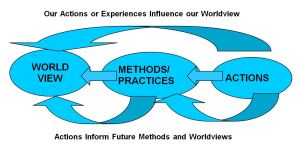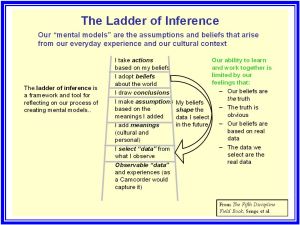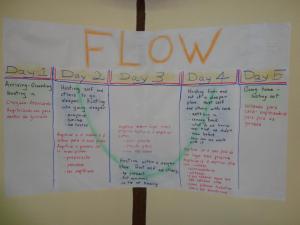Alanna Kennedy turned heads in our opening circle at the March 2014 Art of Hosting offering in St. Paul, Minnesota when she said she had recently hosted a World Café with welders at Emerson, the manufacturing company where she is a production manager. It was so successful she then did one with shippers. A true life long learner (see about Alanna at the end of this post) and a third generation in manufacturing, she is not looking for what can’t be done, she is looking for how results can be achieved and success rates improved. And in both of the Cafés she hosted, the outcome had immediate impact.
In the case of the welders, there was a long term debate surrounding the criteria by which to measure and know if an individual welder was working within and meeting quality guidelines. Everyone had a different idea. In a way, the welders and the supervisors and engineers were speaking different languages with different worldviews. They were not able to hear each other across the worldviews and across assumptions of what they thought they knew about the other. The World Café method was an invitation into letting go of what they thought they knew and into becoming curious about what might be possible.
The original debate was about one measurement only – quality errors. Welders resisted, speaking also about the individual signature of each welder and in some instances unclear written processes. There was a limiting belief, common in many places with many different work groups, that the welders, if left to their own devices, might want to negotiate for the greatest flexibility possible. Welders know, like many trades and professions, that the quality of work of any one individual reflects on the quality of the whole. They want high standards.
Alanna, being on the lookout for what works, sees opportunity in many processes and programs intended to address improving quality and operational standards. Some forecast the failure of rate of programs like Lean and Lean-Six Sigma to develop lasting cultures of continuous improvement to be as high as 60%. She calls this “fake lean”. Overall, she says these programs are great at addressing the structure and technology questions for continuous improvement. However, they are lacking in the methods and tools to support the cultural and social development, or people questions, required to develop and sustain, through time, cultures of continuous improvement. Alanna believes all change starts with social interaction. Change happens and work gets done through people, through the social systems. Enter the Art of Hosting Conversations That Matter, which she found through Action Learning, with an emphasis on working with human systems, recognizing that the wisdom is in the room with the group most directly affected by the proposed change and that there are a few processes specifically intended to elicit the collective intelligence.
After attending a World Café workshop offered by Jerry Nagel of the Meadowlark Institute in Minneapolis, Amy Lenzo of the World Cafe Community and others, Alanna brought fifteen welders from across the three shifts together for two hours in a world café process. They were paid for their time even if they were off duty during the World Café and they were invited into a series of conversations about criteria for assessing a welder’s work. For this particular Café, managers were present but supervisors and engineers were not invited. What emerged in two hours was a resolution to the long impasse and a structure that never would have emerged without this café conversation process.
The welders identified three distinct categories of standards: welding skills, manufacturing processes and the individual signature of the welder. This is a more comprehensive structure than what was proposed by supervisors and engineers and a structure welders were willing to hold themselves and each other accountable to because they want their counterparts to uphold a certain level of professionalism on behalf of the whole. The results were captured in a document that reflected the conversations and that document was approved by HR and executive managers. The end result was the resolution of a long term impasse with a better quality of result than had been previously considered possible.
Alanna then did a World Café with shippers who needed new work stations. Others in the organization had been trying to design a new work station for the shippers but many of the shippers hadn’t been included in the initial planning and they were obviously stalling. They did not like the proposed design. Alanna rounded up shippers from all three shifts for a two hour World Café process. There were three tables of five people. The shippers changed tables, circling around design ideas, sharing what would and would not work until three new work bench designs that they believed would support their needs were developed. In the harvesting, the shippers were able to share their ideas and the reasoning behind their designs with the engineers. The shippers had the opportunity to engage in a different type of dialogue. Again, a resolution to an impasse was obtained within a couple of hours by using the world café process.
Was it worth paying the shippers and the welders for their time? Was it worth a two hour investment of time to call upon the collective intelligence of the group most directly affected by the changes? Was it worth the risk of bringing social technologies to a manufacturing organization? The results speak for themselves.
Many people who have attended an AoH training or are aware of the methodologies like world café, open space technology, circle practice, appreciative inquiry will often say, “That’s really great, but it will never fly where I work.” That’s why Alanna turned heads when she said she worked in manufacturing.
When asked how she might respond to people who say, “It will never work here”, she offered, “You have to careful. I used it where we were stuck and had been working on an issue. In preparation, I bought each of my colleagues a set of books – circle, open space, world café and action learning – and put them on their desks. I talked to them. I first gained the support of my peers.”
She was strategic in her approach. The need, purpose and intention for the café were clear. She knew who she needed to have in the room, and who not to have. She knew the result she was after in each case – eye on the outcomes – and she understood the conditions that would lead to the generative conversations necessary for success. She had the confidence to take, what for some people, is a risk. “A critical piece to understand is that all change is facilitated and begins with human interaction. If you don’t address that, you won’t get the desired results, no matter how good the plan or the technology.”
Why does AoH work? “Because it is not about mimicking what some other company or some other people did to achieve success. It is about adaptive solutions generated from the people and systems most affected.”
About Alanna Kennedy
Alanna loves the manufacturing world. She describes it as “a unique social laboratory” which is why she deliberately returned to this world after completing her PhD. She is a “hands on” manufacturing professional formally trained and experienced in operations and materials management with an active interest in the research and development of social systems within organizations as they pertain to the development and sustainability of cultures of continuous improvement.
Her 2011 doctorate in Organizational Development with an emphasis on successful cultures of continuous improvement with a focus on the facilitation and implementation of Lean, Six Sigma, and SEAM (Socio-Economic Assessment of Management) methods is from the University of St. Thomas, MN, where she also completed her MBA in 1990 with a concentration in operations and systems excellence including the use of lean methods. Her undergrad BA is from the Indiana University Bloomington in Cultural Anthropology and Psychology (1980) with a concentration in social systems and the application of macro economic theory in non-western societies.
She is certified in lean methods by the Society of Manufacturing Engineers. She is CPIM certified by the APICS organization in production scheduling and inventory management, and is a licenced instructor for the global quality standards of electronics with the IPC Association. She is also a licenced Brain Gym instructor, a kinesiology based program which uses physical movement to improve focus, learning and over all performance, combining it with Action Learning and Brain Gym and observing amazing, accelerated results for people working with stress and goal setting.
She will continue to pursue her curiosity about the integration of AoH practices and patterns with continuous improvement philosophies by doing a deeper dive into some of the individual methods and identifying opportunities for application in industrial environments.














